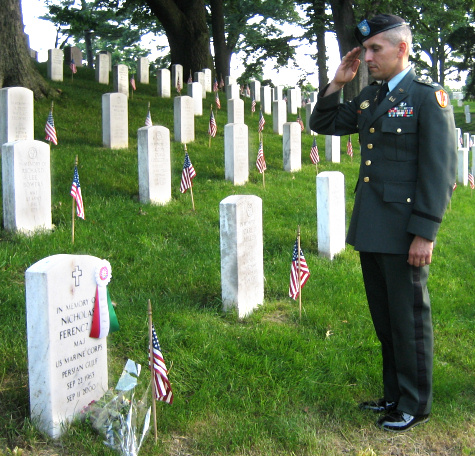 D-Day in Europe
D-Day in Europe63 years ago
June 1944 was a major turning point of World War II, particularly in Europe. Although the initiative had been seized from the Germans some months before, so far the western Allies had been unable to mass sufficient men and material to risk an attack in northern Europe.
By mid-1944 early mobilization of manpower and resources in America was beginning to pay off. Millions of American men had been trained, equipped, and welded into fighting and service units. American industrial production had reached its wartime peak late in 1943. While there were still critical shortages -- in landing craft, for instance -- production problems were largely solved, and the Battle of the Atlantic had been won. Ever increasing streams of supplies from the United States were reaching anti-Axis fighting forces throughout the world.
By the beginning of June 1944, the United States and Great Britain had accumulated in the British Isles the largest number of men and the greatest amount of materiel ever assembled to launch and sustain an amphibious attack. Strategic bombing of Germany was reaching its peak. In May 1943, the Combined Chiefs of Staff had given high priority to a Combined Bomber Offensive to be waged by the Royal Air Force and the U.S. Army Air Forces. By late summer 1943, Allied bombers were conducting round-the-clock bombardment of German industry and communications. In general, British planes bombed by night and American planes bombed by day. Whereas an air raid by 200 planes had been considered large in June 1943, the average strike a year later was undertaken by 1,000 heavy bombers.
After considerable study strategists determined to make the cross-channel attack on the beaches of Normandy east of the Cherbourg Peninsula. Early objectives of the operation were the deep-water ports at Cherbourg and at Brest in Brittany.
Three months before D-Day, a strategic air campaign was inaugurated to pave the way for invasion by restricting the enemy's ability to shift reserves. French and Belgian railways were crippled, bridges demolished in northwestern France, and enemy airfields within a 130-mile radius of the landing beaches put under heavy attack. Special attention was given to isolating the part of northwestern France bounded roughly by the Seine and Loire Rivers. The Allies also put into effect a deception plan to lead the Germans to believe that landings would take place farther north along the Pas de Calais.
Opposed to the Allies was the so-called Army Group B of the German Army, consisting of the Seventh Army in Normandy and Brittany, the Fifteenth Army in the Pas de Calais and Flanders, and the LXXXVIII Corps in Holland -- all under command of Field Marshal Erwin Rommel. Commander of all German forces in western Europe was Field Marshal von Rundstedt who, in addition to Group B, also had at his disposal Group G composed of the First and Nineteenth Armies. In all, Von Rundstedt commanded approximately fifty infantry and ten Panzer divisions in France and the Low Countries.
Despite unfavorable weather forecasts, General Eisenhower made the decision to attack on June 6, 1944. At 0200 that morning one British and two American airborne divisions were dropped behind the beaches in order to secure routes of egress from the beaches for the seaborne forces. After an intensive air and naval bombardment, assault waves of troops began landing at 0630. More than 5,000 ships and 4,000 ship-to-shore craft were employed in the landings. British forces on the left flank and U.S. forces on the right had comparatively easy going, but U.S. forces in the center (Omaha Beach) met determined opposition. Nevertheless, by nightfall of the first day, large contingents of three British, one Canadian, and three American infantry divisions, plus three airborne divisions, had a firm foothold on Hitler's "fortress Europe."
***
War in the Pacific <> World War II
After Pearl Harbor the Japanese quickly gained control over a huge area of the Pacific, from the Phillipines to Burma to the Aleutians to the Solomons.
While the Japanese enjoyed the advantage of interior lines of communication, they had somewhat overextended themselves. Once the Allies became strong enough to threaten their perimeter from several directions, the advantage would be lost, since Japan did not have and could not produce enough planes and ships to defend in force at all points.
The turning point in the Pacific theatre came in mid-1942 with history's first great carrier battles. In the Coral Sea the U.S. Navy checked the Japanese. In the Battle of Midway it defeated them.
After the Battle of Midway, the Allies were able to launch a counter-offensive. The first stage of the offensive began with the Navy under Admiral Nimitz and Marine landings on Guadalcanal and nearby islands in the Solomons. At the same time, the Army under General MacArthur with Australian allies set out to take New Guinea's Papuan peninsula. After long, bloody struggles, both campaigns succeeded.
From this point on, Nimitz and MacArthur engaged in island-hopping campaigns that bypassed strongly-held islands to strike at the ememy's weak points. Campaigns against the Aleutians and Rabaul succeeded in stopping the Japanese advances and secured bases for Allied advances on Japan.
While MacArthur pushed along the New Guinea coast, preparing for his return to the Philippines, Nimitz crossed the central Pacific, via the Gilberts, Marshalls, Marianas, Carolines, and Palaus. Once the Marianas were taken, it would be possible to use them as bases from which the new long-range B-29 bombers could strike at the heart of Japan.
The advance through the Central Pacific got under way in November 1943 with the seizure of two islands, Tarawa and Makin in the Gilberts. Marines landed on Tarawa on November 21 and took the island in a four-day fight at a cost to the Marines of some 3,000 casualties. Army troops overwhelmed the small Japanese garrison on Makin between November 20 and 24, 1943.
During January and February 1944, Admiral Nimitz proceeded to positions in the central and western Marshalls. The principal islands taken were Kwajalein, which was invaded by an Army force on February 1, and the islands of Roi and Namur, which were invaded by Marines on February 3 and 6.
From Kwajalein a naval task force, moving west 340 miles with a regiment each of Marines and infantry, captured a Japanese air base on Engebi in the Eniwetok Atoll on February 17-19, 1944.
Meanwhile, on February 16, Nimitz had launched a massive carrier raid on Truk in the central Carolines, long considered Japan's key bastion in the central Pacific. This raid revealed that the Japanese had virtually abandoned Truk as a naval base, and a plan to assault that atoll in June was abandoned. Instead, Nimitz drew up plans for an invasion of the Marianas in June, to be followed in September by an advance into the western Carolines.
Admiral Nimitz invaded the Marianas in June 1944. Amphibious assaults were made on Saipan on June 15, on Guam on July 20, and on Tinian on July 23, 1944. All three islands were strongly garrisoned by Japanese troops who contested every yard of ground.
Loss of Saipan precipitated a political crisis in Tokyo and brought about the fall of the Tojo Cabinet. The Japanese sallied forth to offer battle to the U.S. Pacific Fleet. They hastily reassembled their fleet from Biak and the Philippines and sailed north to defend the Marianas area, but lack of land-based air support made it impossible to surprise the U.S. naval contingents under Admiral Spruance.
In a massive air battle that took place on June 19, 4 days after landings on Saipan, the Japanese lost more than 400 planes to an American loss of less than 30. Stripped of carrier planes, the Japanese fleet fled westward, but American planes in pursuit were able to sink several vessels, including three carriers.
During this engagement, known as the Battle of the Philippine Sea, only three American ships were damaged. This victory paved the way for eventual success in the Marianas, and provided a demonstration of the interdependence of operations in the Southwest and Central Pacific Areas.
Capture of the Marianas brought Japan within reach of the Army Air Forces' huge new bomber, the B-29, which was able to make a nonstop flight of the 1,400 miles to Tokyo and back. Construction of airfields to accommodate B-29's began in the Marianas before the shooting had stopped, and in late November 1944 the strategic bombing of Japan began.
The last two major campaigns of the Pacific war -- Luzon and Okinawa -- were still to come. But Japan was essentially beaten. It was defenseless on the seas; its air force was gone; and its cities were being burned out by incendiary bombs. The atomic bombings of Hiroshima and Nagasaki on August 6 and 9 and the Soviet declaration of war on 8 August forced the leaders of Japan to recognize the inevitable.
On August 15, 1945, Emperor Hirohito announced Japan's surrender and ordered Japanese forces to lay down their arms. Since the war in Europe had already been won, V-J Day, September 2, 1945, marked the end of the greatest war in human history.












